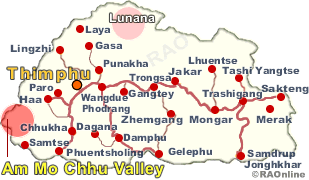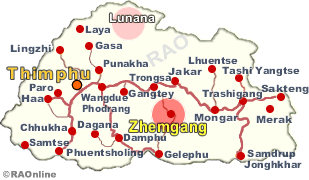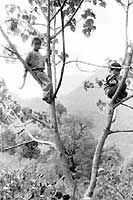|
The
Lhops of the Am Mo Chhu Valley |
 |
Bhutan People Lhop |
|
|
 |
|
Lhop - One
of Bhutan's least known ethnic group
|

|
 The
controversial name The
controversial name |
 |
The
Director of CAPSCD and NIE (Paro), Jagar Dorji, has studied one of Bhutan's
least known ethnic group, the Lhops of the Am Mo Chhu valley. Excerpts
from his research paper presented at a colloquium in Thimphu this week
is reproduced below. Kind and tolerant the later settlers called the Lhops
daya, meaning kind-hearted.
Daya soon assumed its corrupt form, Doya. The
word Doya, is derived from the Nepali word daya (meaning kind).
|
When the
Nepalese immigrants came to these parts of the kingdom, they came across
this indigenous community already living in the region.
The
shy, kind and gentle people of the Lhop community obviously treated the
newcomers rather kindly. This included the generosity of allowing the latter
to till their ancestral lands in exchange of gifts of chhang, a weakness
of the Lhops.
The
settlers called their hosts "daya" as a gesture of gratitude. Soon they
came to be known as Doya, a corrupt form of daya. This name was so widely
used that even many of the Lhops themselves began to use it commonly. There
is yet another confusion. To some people, the Doyas and Taba Dramtoeps belong to different ethnic groups. Taba and Dromtoekha are villages where
the Tabaps and the Dromtoeps live, while the Lhops live mainly in Lhotu
and Kuchu, Sanglung and Satakha villages
Chakravarti
(1978) thinks the Lhop people were the semi-nomadic group that took care
of the cattle belonging to the permanent settlers of Haa and Paro. Aris
believes that the Lhops may be the same tribe which lives in Upper and
Lower Toktokha in Chukha Dzongkhag. In fact, Aris mentions Toktop as a
common name for the Lhops of Dorokha Drungkhag, Taba Dramtoekha and Toktokha.
Aris would also have us believe that the three groups may have branched
off from the original Dung from the Dungna valley in the western part of
Chukha Dzongkhag.
The older people in the Lhop villages say that until
the 1960s the entire region of Lhop was brought under the administrative
jurisdiction of a certain Dung Nyerpa and hence the connection. The Toktop
males wear their garment "crossed over the chest and knotted at the shoulders"
and that definitely suggests that the Lhops and the Toktops belong to the
same ethnic group. If so, the Lhop territory extends right into the western
part of Chukha beyond the Am Mo Chhu valley. Aris refers to these people
as the earlier settlers of Bhutan who might have been pushed to these corners
by the more influential and culturally advanced people of the north and
central Bhutan.
top
| The
origin of the Lhop
|

|
 |
| The
history and the origin of the Lhop has remained a mystery. The folk tales
that could have given us some glimpses into their past are filled with
myths, and the oral tradition is not very strong. But it is irrefutable
that the Lhops had lived and evolved as a part of the Am Mo Chhu valley
since time immemorial. It is believed that once the region around the Am
Mo Chhu valley was filled with the Lhop population. Their tribe apparently
lived as far as the Jaldakha valley further west, now known as Bara-Tendu,
but had been wiped out probably by some deadly diseases or by the communal
wars reducing the present population to some 180 households. |
|
Lhops
literally means southerners, a term mostly used by the people of the Paro
and Haa valleys. Its use may also go back to the ancient Tibetan reference
of Bhutan as Lhop Yuel, the country to the south of Tibet and the people
of Lhop Yuel as Lhop.
Elsewhere
it has been said that later migrants from Tibet might have pushed them
away to the southern foothills. According to a tradition in Satakha, one
of the Lhop villages, they worship a deity called Talang which is said
to have its origin in the Dop-Shari village in Paro. The informants who
have never been to Paro themselves, believe that there is an ox-shaped
boulder which is the image of the Ta-lang deity they worship in the Dopu
village.
top
| The
Lhops and the early Bhutanese |

|
 |
The Lhops and the others
like the Moenpa and the Mangdeps may have been the descendants of the so
called Ri - Dragpa (people of the mountainous terrain) described as short
and sturdy natives of an ancient country. Elsewhere the Lhops are identified
with the Kiranti people who were presumably the original inhabitants of
the Sub-Himalayan foothills, but later evolved into separate and unique
cultural pockets due to physical isolation from each other over a long
period of time. |
The rough terrain of the country and the self-sustaining
means available in the valley could be responsible for this isolation.
There is yet another people called the Toto to the south of the Taba Dramtoekha.
The Lhops are definite that they share no common roots with the Toto people because their languages are different. For reasons that are more geographical
than historical or political, the Lhops have remained isolated from the
fast developing culture in most parts of the country for a long time. With
the Tegola Mountain range as a natural barrier between the Lhops and the
rest of the country, the community may have had less access to the forces
that would otherwise enhance social and cultural interaction.
Elderly Lhop
people consider Zhabdrung Ngawang Namgyal as a master founder of the religion
for the Lhops. One of the explanations they provide refers to the present
day Sombekha village in the upper part of the Am Mo Chhu valley. The main
protective deity of the Sombeyhka, Kuntuzangpo, is said to have been brought
by a Lhop who had worked in the court of the Zhabdrung. The Lhops even
sing songs extolling the Zhabdrung's virtues and fame.
top
| The
settlement |

|
 |
| Several
communities are found living in separate village settlements on both sides
of the Am Mo Chhu valley. Rangtsekha, Doga, Dorokha, Satakha, Sanglung, Lhoto-Kuchu,
Lotok and Drambey villages are on the southern part of the Am Mo Chhu while
the villages of Thangtokha and Denchuka and several others face south in
the northern slopes of the valley. The inhabitants of Rangtse village are
said to be originally a part of the greater Lhop community and are called
Yar-lhop by the people of the Lhoto-kuchu villages. But they live in villages
in the upper part of the valley and seem to have little contact with the
community down the valley. The language of the Yar-lhopshas also evolved
to a great extent that it has lost its close affinity with the original
Lhop language. The Yar-lhops themselves believe that they are different
from the Lhops and speak a language that is more like the one spoken by
the people of Sombeykha, which is closer to Rangtse. |
|
The
folklore of the Lhops contain interesting stories of their territorial
extent. The Lhop tradition of offering has similar connotations that prevail
in the Nyonked speaking areas.
"Sele
La Wo Chey; Mainaguri Ya Chey" in Lhop dialect means below Sele La and
above Mainaguri while another indicates that the Lhop country stretched
from Selela in the north to Mainaguri in the south, and from Seti in the
east to Jaldhakha in the west. "Ti" in the Lhop language means water or
flowing stream and any stream with a "ti" affixed to its name, therefore,
could indicate the extent of the Lhop territory.For example, the Amo Chhu
is called Mo-ti (meaning Mo Chhu) and, likewise, Yash-ti, Kam-ti and Dam-ti.
Later immigrants added "khola" to these names and thus the Seti Khola and
the Hati Khola.
"Doo" in the Lhop dialect is the name of a tree and the
Do-ti that flows from the Phuentsholing town is named after the trees that
are commonly found around its sources. The Damdum river which flows out
into India draining the valley to the north of Samtse town has its original
name in the Lhop language. It consists of two tributaries, the Dam Ti and
the Dom Ti. Dam Ti originates in the slopes of a lofty hill range seen
in the northeast opposite the Samtse town while the Dom-ti emerges from
the southern slopes near the Yeba La range.
The Lhops believe that their
people had lived in Sibsoo, Bara, Tendu, Chengmari and in the south of
the Yaba La range but had been wiped out by a terrible epidemic. When it
happened is not known.
A 46-year old man, Daw Tshering, says his great
grand-mother Tsurjemo had survived the epidemic and was brought to Satakha
village by a man named Tsang Doji as his bride. Tsurjemo was 12 when she
came to Satakha in which case the epidemic might have occurred around 1867
just after the Duar War between Bhutan and the British. After the epidemic
the settlements south-east of the Yaba La range were abandoned for a long
time.
Then the Haaps came and grazed their cattle and later the Nepalese
immigrants used the land. The epidemic theory explains the reduction of
the Lhop population to its present size. This epidemic could have spread
from the plains with which the Lhops of the foothills south of the Yaba
La range had contacts. The fact that the Am Mo Chu valley was unscathed
suggests that the killer disease did not reach the other side of the mountains
where the Lhops are found today.
top
| The
people |

|
The
Lhops are short and sturdy in appearance. Both men and women have almost
the same body stature - generally around 4-5 feet - and the retarded growth
may have been caused by the intra-community marriage they still continue
to maintain. People in the village of Satakha who the Lhops say are not
pure Lhops but born through inter-marriages with people from other villages,
appear taller and healthier. But by no means should the Lhops be under-estimated
in their strength, courage and feat. They are born climbers and daring
athletes. The grasses for roofing their houses are found on steep rocky
scarps that are quite intimidating and spine chilling even to look at.
But they climb these precarious precipices nimbly and seemingly non-chalantly
to collect the grasses. Among the Lhop people, it is not uncommon to find
people as old as 100 years of age.
top
| The
Lhop community |

|
Their houses and living environment have not changed much though modernism has
begun to influence their taste in dresses and diet. They live closely,
marry within the community, often among cousins, and worship local deities
called Zhipda-Neda. They are very simple and humble by nature and quite
tolerant. Very few are educated. The highest a Lhop has achieved in education
is the Primary Teacher's Certificate in 1995. Another young man has been
enrolled as a monk at the Samtse rabdey. The teachers at the Sengten Primary
School, established in 1983, have been encouraging the people to educate
their children but seldom successfully. The drop-out rate, however, has
been falling.
Marriages outside their community is discouraged because
it is opposed to their ancestral tradition. Otherwise, the Lhops maintain
a sound relationship with each other within the village and like helping
each other to maintain their strong family ties. There is no bitterness
among the Lhop people about other people coming and occupying their land.
The settlers generally see them as a friendly and simple-minded people
who love to drink, chat and care little for tomorrow.
Due to their intra-community
marriage, every Lhop is somehow related to one another. Cross cousin marriages
may be responsible for a number of cretins found in their community as
well as their short stature. The other reason may well be the lack of iodine
in their diet as in other parts of the mountainous terrain of Bhutan. Loyalty
and commitment among the Lhops is very important and they may even sacrifice
their lives for the community.
| Contributed
by KUENSEL, Bhutan's National Newspaper |
 |
| Information on Bhutan |
 |
|





